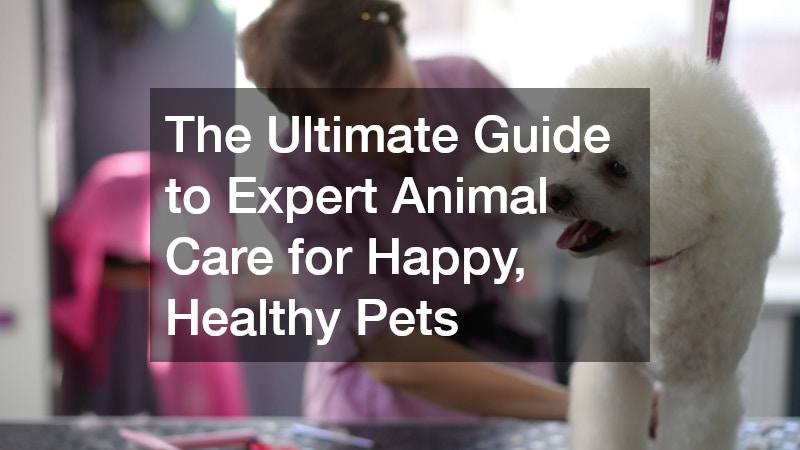Welcoming a new pet into your home is an exciting and joyous occasion filled with love and the promise of companionship. However, pet ownership is also a significant responsibility that requires careful planning and commitment. From ensuring access to quality healthcare to creating a safe and stimulating environment, taking on a new pet involves understanding their unique needs. Whether you’re adopting a kitten, puppy, or another type of animal, their happiness and well-being should always come first.
Pets bring endless joy, but they also require dedicated care and attention. Essential first steps include finding the right veterinarian, addressing potential health issues, and training your pet effectively. Additionally, preparing your home with appropriate safety measures—like secure enclosures and pet-friendly systems—ensures a nurturing environment for your furry friend.
This guide explores various aspects of caring for new pets, including their health, keeping them active, and setting up your home to cater to their needs. From fence installations to creating safe play zones and maintaining a clean living space, you’ll find practical tips to help your new pet settle in and thrive.
Finding the Right Healthcare

Securing proper healthcare is one of the most important steps in caring for a new pet. Choosing a reputable veterinary clinic should be a top priority. Vets do more than administer routine vaccinations—they offer valuable guidance on nutrition, behaviour, and overall health.
When selecting a vet, consider factors such as location, operating hours, and emergency services. Building a trusting relationship with your veterinarian is crucial to your pet’s long-term health. Familiarising yourself with local clinics and services ensures you’re prepared to handle medical emergencies.
Regular vet visits help monitor your pet’s growth and address potential health concerns early. Introduce your pet to the vet in a calm and positive manner to reduce any anxiety associated with medical visits. Early engagement with veterinary care lays the foundation for responsible pet ownership.
Addressing Immediate Health Concerns
New pet owners often encounter health challenges, such as skin problems caused by allergies, parasites, or infections. Common symptoms include redness, flaking, or excessive scratching. Identifying these signs early is key to effective treatment.
Consult a vet for accurate diagnoses and tailored treatment plans. Routine grooming and regular skin checks can help prevent these issues from escalating. Providing proper nutrition and maintaining a clean living environment also contributes to your pet’s overall skin health.
Pay attention to any changes in behaviour or appearance that may indicate an underlying health issue. Prompt action and early treatment can prevent minor problems from developing into serious conditions, leading to a healthier and happier life for your pet.
Keeping Your Pet Active
Like humans, pets require regular exercise to maintain their physical and mental well-being. For animals facing physical challenges, pet physiotherapy can be a valuable tool to improve mobility and overall health. Exercise is essential in preventing obesity and other health-related issues.
Dogs, in particular, need daily walks and active play sessions. Activities like fetch or agility training not only enhance their fitness but also strengthen the bond between you and your pet. Regular exercise provides emotional stimulation, reducing anxiety and behavioural issues.
For pets with specific health conditions, your vet may recommend specialised physiotherapy. These treatments can assist with recovery, improve mobility, and enhance quality of life. Tailoring exercise routines to your pet’s unique needs ensures they remain healthy and content.
Teaching Good Habits
Training your new pet in good habits is essential for a harmonious household. Professional dog trainers and animal behaviourists can offer invaluable assistance, teaching pets essential skills and boundaries.
Effective training fosters good behaviour while strengthening the bond between humans and animals. Professional guidance can range from basic obedience to advanced behavioural training. Socialising your pet early helps prevent issues like aggression or fearfulness.
Consistency and positive reinforcement are key to successful training. Rewarding desirable behaviours helps pets learn quickly and feel motivated. By investing time and patience in training, you can create a loving and disciplined environment for your new pet.
Creating Safe Spaces
Installing Screen Enclosures
For homes with outdoor spaces, screen enclosures can provide a safe area for pets to enjoy the outdoors without exposure to hazards. These enclosures offer protection from harsh weather and prevent curious pets from wandering off.
Around swimming pools, screen enclosures are particularly beneficial, reducing the risk of accidental water exposure. They provide a balance between freedom and safety, allowing pets to explore within secure boundaries.
Professionally installed enclosures can be customised to meet both practical and aesthetic requirements, ensuring a safe and appealing outdoor space for your pet.
Establishing a Pet-Friendly Lawn
A healthy, well-maintained lawn isn’t just visually appealing—it also provides a safe play area for pets. Installing an irrigation system can keep your lawn lush and vibrant while minimising allergens and pests.
Regular lawn maintenance, including watering, mowing, and fertilising, creates a welcoming outdoor space. Avoid using toxic chemicals or plants that could harm your pet. By planning strategically, you can design a yard that’s both pet-friendly and attractive.
Building Secure Play Areas

Fence Installation
Installing a secure fence is vital to creating a safe environment for your pet. A well-designed fence keeps pets contained and protects them from external dangers such as traffic or other animals.
Choose fencing materials and designs that suit your pet’s size, activity level, and behaviour. Regularly inspect fences for damage or wear and address any issues promptly to maintain a secure boundary.
Adding Security Gates
Adding a security gate enhances outdoor safety further. Select gates with sturdy locking mechanisms to prevent unauthorised access and ensure your pet’s safety. Automated gates provide added convenience and security, especially for curious or intelligent animals.
Regular maintenance of gates ensures their continued functionality and reliability, offering peace of mind for pet owners.
Implementing Home Security Systems
Installing a comprehensive home security system can help keep an eye on your pet’s activities. Modern systems allow for real-time monitoring via smartphones, providing reassurance when you’re away.
Features such as night vision, motion detection, and remote access optimise security and enable you to track your pet’s movements. In addition to deterring intruders, these systems help ensure your pet’s safety at all times.
Maintaining Cleanliness
New pets often bring unavoidable messes, making cleanliness a priority. Professional carpet cleaning can effectively tackle pet-related stains, odours, and allergens.
Regular cleaning not only improves hygiene but also prolongs the life of your carpets. Preventive measures, such as using pet-friendly cleaning products and addressing accidents promptly, can minimise stress for both you and your pet.
A clean and well-maintained home creates a welcoming environment where pets feel comfortable and loved.
Conclusion
Bringing a new pet into your home is a deeply rewarding experience filled with joy and companionship. However, it also requires dedication to their health, safety, and happiness. Addressing key aspects such as veterinary care, proper training, and secure environments fosters a harmonious relationship between you and your pet.
Investing in thoughtful residential planning, including fencing, enclosures, and security systems, ensures a nurturing environment for your furry friend. These measures not only protect your pet but also enhance your home’s overall appeal.
By making informed decisions and showing care and respect, you can build a loving bond with your new pet. Every step—from healthcare to training—contributes to a fulfilling journey of pet ownership, bringing joy and enrichment to your life for years to come.




